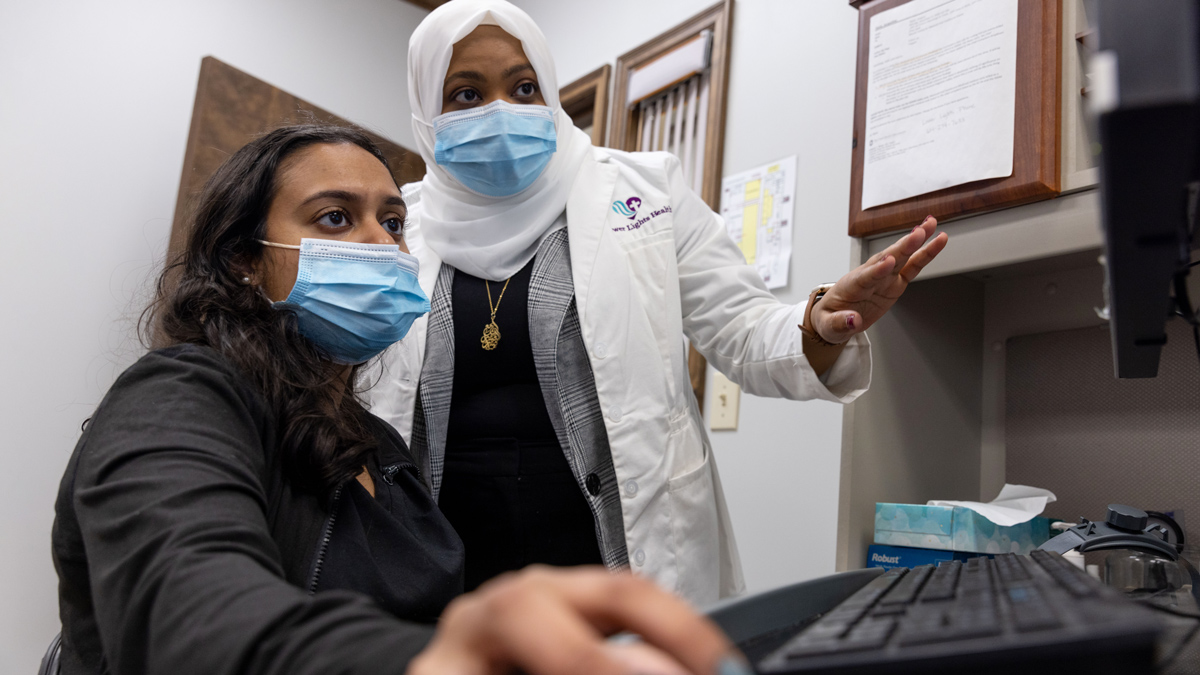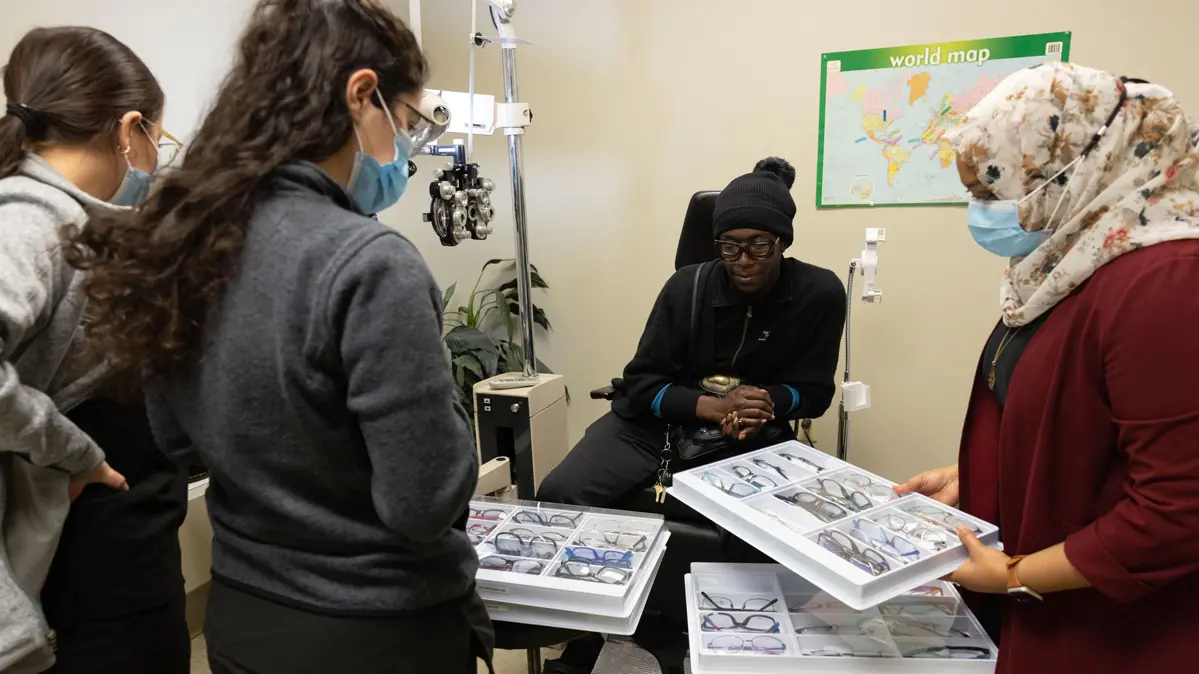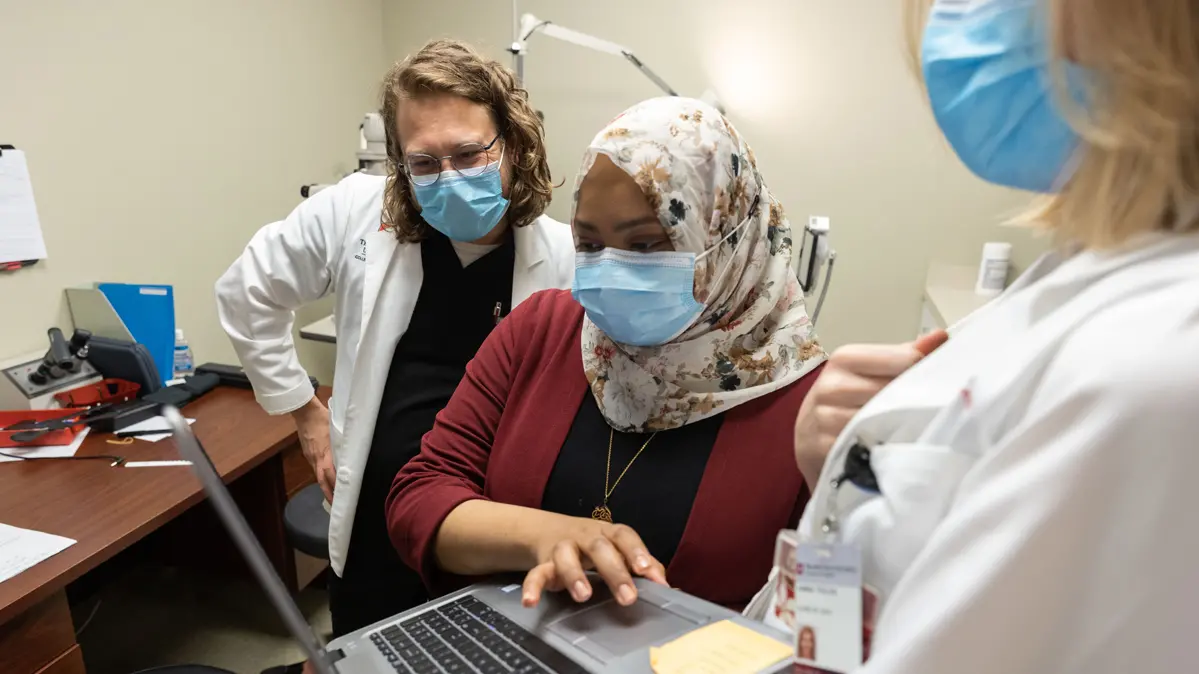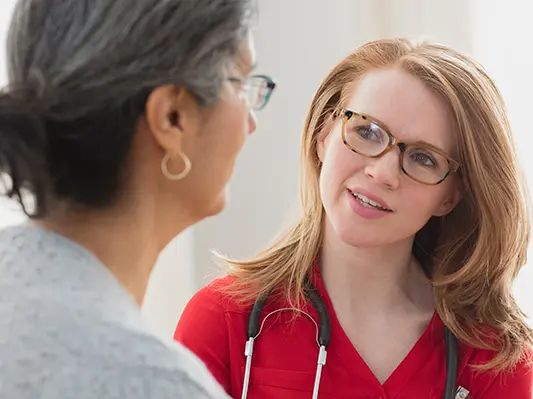Dr. Mawada Osman and the power of seeing
Inspired by her professors and personal immigration experience, this compassionate optometrist provides quality care to disadvantaged community members and teaches her students to do the same.

Dr. Mawada Osman (right) coaches third-year optometry student Sidney Parks during a practice round of measuring another student’s eyes at Ohio State’s clinic in the Faith Mission homeless shelter. Osman, an assistant clinical professor, leads optometry services there and at a second university-operated clinic.
“I was a little overwhelmed,” Osman remembers. “Patients would share their background, living conditions and medical conditions, not just details about their eyes. I needed to make sure I got down the information, but I also needed to be present in the moment.”
How to be present — she learned that from Nerderman.
“I admired the time Dr. Joan took with her patients and the level of kindness she showed them,” Osman says. “She sat down and listened to them. I remember saying, ‘One day, if I were to go into eye care, that’s the type of interactions that I want with my patients.’”
Nine years later, Osman is getting what she wanted. And more.
After earning her doctor of optometry degree at Ohio State and completing a one-year residency in Michigan, Osman returned to the university in 2021 to become chief of optometry services at Faith Mission — replacing her first mentor in the field, Nerderman, who retired.
Osman also is director of optometry services at Lower Lights Christian Health Center, which serves low-income people in Columbus, and where, as a student, Osman did a rotation with another role model — Dr. Jackie Davis ’81 OD, ’08 MPH, who ran the Lower Lights eye clinic for eight years and a similar Ohio State clinic for seven years before that.
“I’m so glad Mawada chose to come back to Ohio State,” Davis says. “She’s an excellent clinician and an excellent communicator, and she truly, truly cares about her patients.”
Like her mentors before her, Osman is teaching third- and fourth-year optometry students who do rotations at the Faith Mission and Lower Lights clinics.
“I’m getting the best of both worlds,” Osman says. “I can work in a community health clinic and also work directly with students and encourage them.”
Treating and teaching
On a recent Wednesday afternoon, Osman huddles with four optometry students in her small office at Faith Mission, where the College of Optometry requires all of its third-year students to complete a semester-long rotation. It is the students’ first day with patients. They’ll perform 90-minute exams and dilate each patient’s eyes to conduct a comprehensive analysis.
Many Faith Mission patients have never had preventive care; it’s common to see patients with cataracts or an advanced ocular disease, such as glaucoma or macular degeneration, all of which can lead to blindness.

Osman and her students look over the list of scheduled patients. “One of our patients is from Algeria,” Osman notes. “She’s 70 years old and speaks Berber. We’ll need to get a translator for her.”
The clinic uses an online language service to provide translators, who join conversations virtually. Student Sidney Parks ’20 heads off to arrange for a translator and get the patient’s medical history.
Next on the patient list is Cristal. (She and other patients asked to be identified by first name only.)
“She’s been to the clinic before,” Osman says. “She has diabetes and cataracts. We referred her to an ophthalmologist for surgery, but it doesn’t look like she followed up.”
Lack of follow-up is a common problem at clinics such as Faith Mission and Lower Lights, and it can be both understandable and frustrating. Some patients struggle with arranging for transportation or time off work. Others face family or health problems. The clinics’ social workers and Osman do their best to stay in touch with patients, whose lack of stable housing and phones can make that difficult.
“Would you like to take Cristal?” Osman asks Austin DeGroff. He nods. Osman arranges matches for the other two students, then goes to check on Parks and her patient, Tayakout.
Entering the room, Osman smiles and greets Tayakout, who is accompanied by her 30-year-old son, Samir. Osman quickly learns that Samir speaks English, Berber and Arabic. A native of Sudan, Osman sees an opportunity to make a connection and chats with Samir in Arabic for a few moments.

Tayakout, who has been sitting stiffly, relaxes her shoulders as her son and the doctor talk.
Osman switches to English, and Parks reports what she learned about Tayakout: Her health is good but her vision is blurry, and she has not had an eye exam in years. Now, Parks is ready to start the exam.
“Let’s call the translator,” Osman says, and a woman appears on an iPad screen. She speaks Berber, including medical terms Samir doesn’t know. After ensuring the connection is good, Osman leaves to check on DeGroff and Cristal.
“I can’t see,” Cristal tells Osman. “It’s making life very hard.”
“I’m sorry to hear that,” Osman says. She asks DeGroff for an update, and he reports that Cristal’s cataracts have progressed. Her vision loss is profound.
Osman gently asks Cristal why she didn’t follow up with the ophthalmologist last year.
“I was scared,” Cristal says. “I shut down when I heard the word ‘surgery.’ I don’t like surgery.”
Cristal recounts that she’s had a hard year. Her diabetes worsened. She fell and hurt her shoulder. She lost her apartment, and her daughter is sick.

“We’re here for you,” Osman says, gently patting Cristal’s arm.
Then Osman peers through a scope at Cristal’s eyes. She and DeGroff show Cristal a model of an eye, explaining what cataracts are and how surgery can remove them. They take their time.
After an hour and a half, Osman asks Cristal, “Do you have any questions?” The doctor always ends visits with that question to make sure patients understand their condition and know what steps to take next. Cristal asks for more details about surgery and then says she feels more comfortable with the idea.
“Thank you for being patient,” she says to Osman. “We need more doctors like you.”
The afternoon moves along quickly. In working with students, Osman’s style is collaborative: “What do you think we should do?” she often asks. Her gentle voice and wide smile create a sense of ease. And while she works to boost students’ confidence and improve their technical skills, she has an additional goal.
“I want to give my students the skills they need to work with patients regardless of their backgrounds,” she says. “I want to prepare them to be the best advocates they can be for those who are less fortunate.”
Seeing and inspiring
Osman has met doctors who don’t take time to communicate or explain a medical condition, especially if there’s a language barrier.
“I’ve accompanied my mom on her doctor visits,” she says. “Although she understands English well, it can sometimes be hard for her to communicate her concerns in a non-native language. Some of her doctors barely look her in the eye, so I understand how that feels. I make it a point to talk to my patients, to get to know them. For my patients who speak different languages, I try to learn a few words in their own language to make them feel welcome.”
Osman’s awareness stems from her experience when she moved to the United States from Sudan at age 14. While she’d learned some English in Sudan, it was difficult to navigate high school classes while primarily speaking Arabic.
The stakes were high. “I was really stressed because I came in 10th grade, and I had to take the Ohio Graduation Test,” she says. “I knew if I didn’t pass it, I couldn’t graduate.”
Her family’s strength and encouragement motivated her, she says, not just to pass the test, but to go on to take college-level courses during high school. Those helped Osman finish her undergraduate biology degree at Ohio State.
Health care had always interested her, and then, as now, she felt strongly that everyone should receive care, regardless of their means.
“It is more than just the eyes with Dr. Osman. She looks at the person in the chair before the patient in the chair.”
“Unfortunately, health care in Sudan isn’t the greatest,” she says. “I witnessed many people lose their lives or their vision because of an inability to afford quality care, not being near health care services or not knowing they needed to see a doctor because of poor health literacy.”
The loss of vision especially troubled her.
“People go blind from simple things like cataracts, which are known as ‘white water’ in Sudan. It’s frustrating, because I know the solution for cataracts is simple in this day and time, yet many people go blind because they don’t have access to care.”
When she arrived in Ohio, she was surprised to learn that millions of Americans also lacked access to health care. Even with the passage of the Affordable Care Act of 2010, many Americans still can’t afford to buy an insurance plan, or if they do, their plan offers limited coverage and high deductibles.
Osman knows she alone can’t change national health care policy, but she can do her part to improve residents’ quality of life in the city she calls home.
In 2022, Faith Mission’s eye clinic served 850 people. Of those, 400 were uninsured and 300 didn’t have housing. The eye clinic at Lower Lights served about 1,000 people last year, Osman says.
She hopes more students will be inspired by their experience at the two health clinics to help the less fortunate.
Mitchell Pulleo, a third-year student in the College of Optometry, says Osman opened his eyes to the need in the community. He recently completed a rotation at Faith Mission, where he was inspired by Osman’s care and compassion.
“It is more than just the eyes with Dr. Osman,” Pulleo says. “She looks at the person in the chair before the patient in the chair.”
He considers Osman a role model. “She’s instilled a love of community outreach in me.” When it came time to sign up for an additional rotation in fall 2023, he chose Lower Lights.
“There are things you learn from Dr. Osman, these human interactions with patients, that are not covered in the classroom,” Pulleo says. “In my lecture courses, I’ve learned how to diagnose disease and how to refract [the eye to determine a prescription], but when you spend time with Dr. Osman, that’s when you learn how to practice from the heart.”







